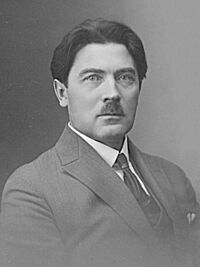Johannes Aavik facts for kids
Quick facts for kids
Johannes Aavik
|
|
|---|---|
 |
|
| Born | December 8, 1880 November 26, 1880 [O.S] Randvere, Estonia, Russian Empire
|
| Died | March 18, 1973 (aged 92) |
| Occupation | Philologist Fennophile |
Johannes Aavik (born December 8, 1880 – died March 18, 1973) was an important Estonian language expert. He was a philologist, which means someone who studies language and literature. He also loved the Finnish language and culture, making him a Fennophile. Aavik played a big part in making the Estonian language more modern and developed.
Early Life and Learning
Johannes Aavik was born in a place called Randvere, on Saaremaa island in Estonia. This was back when Estonia was part of the Russian Empire. He went to the University of Tartu to study history. He also studied at the University of Nezin in 1905.
Aavik was part of a group called the Young Estonia movement. Later, he earned a special degree called a doctorate in Romance languages. He got this degree from the University of Helsinki in 1910.
From 1926 to 1933, Aavik taught Estonian and French at Tartu University. In 1934, he became the Chief Inspector of Secondary Schools for the Estonian Ministry of Education. He held this important job until 1940. In 1944, he had to leave Estonia because of the Soviet occupation. He then lived in Stockholm, Sweden, for the rest of his life.
Developing the Estonian Language
Johannes Aavik believed the Estonian language needed to change and grow. For a long time, it had mostly been used by farmers. But now, Estonia was becoming a modern country. The language needed to be ready for new ideas and technologies.
Aavik wanted to make the grammar and spelling of Estonian more standard. He also felt the language needed new words for modern topics. He thought it should sound good and be easy to use.
In 1912, he started writing articles about how to improve Estonian. He suggested borrowing many words from Finnish. Many of his ideas were quickly accepted. These new words became a regular part of the Estonian language.
From 1914, Aavik began creating completely new words. He wanted to replace long or awkward Estonian words. For example, he suggested relv for "weapon" instead of sõjariist (which meant "war tool"). He also proposed roim for "crime" instead of kuritöö ("evil deed"). Another example is veenma for "convince" instead of uskuma panema ("put into believing").
He often tried to avoid the sounds t and s. He also preferred shorter words. Aavik liked the sound o in words more than u, which is common in some Estonian dialects. Many of his new words were created from scratch. However, some experts believe he was influenced by words from other languages. These included Russian, German, French, Finnish, English, and Swedish. For instance, roim might have come from the English word crime.
Aavik even tried to change Estonian grammar rules. He suggested new ways to form plurals and superlatives. He also proposed new verb forms. But not all of his grammar ideas became popular. For example, he tried to add a future tense for verbs. He also wanted a special pronoun for females. But these ideas did not get much support.
Aavik wrote many essays and translated texts to share his ideas. He had many supporters, but also some people who disagreed with him. In 1919, he published a dictionary with 2000 new words. About 30 of the words he created are still used today. These include laip (meaning 'corpse') and mõrv (meaning 'murder').
His main ideas were about usefulness, beauty, and keeping the language Estonian. He wrote about these ideas in his book Keeleuuenduse äärmised võimalused (Extreme Perspectives of Language Innovation) in 1924.
After 1927, language changes slowed down. A new law made it mandatory for schools to teach standard Estonian. This was based on the Estonian Orthographic Dictionary (1925) and Estonian Grammar (1927). However, some of Aavik's words that were forgotten have been brought back by writers more recently.
Death and Lasting Impact
Johannes Aavik passed away in Stockholm, Sweden. On September 26, 1992, a group called the Johannes Aavik Society was started in Tallinn, Estonia. This society studies the Estonian language. They especially focus on the parts of the language that Johannes Aavik worked on. The society has many members and publishes a special paper called "Keeleuuenduse Kirjastik."

